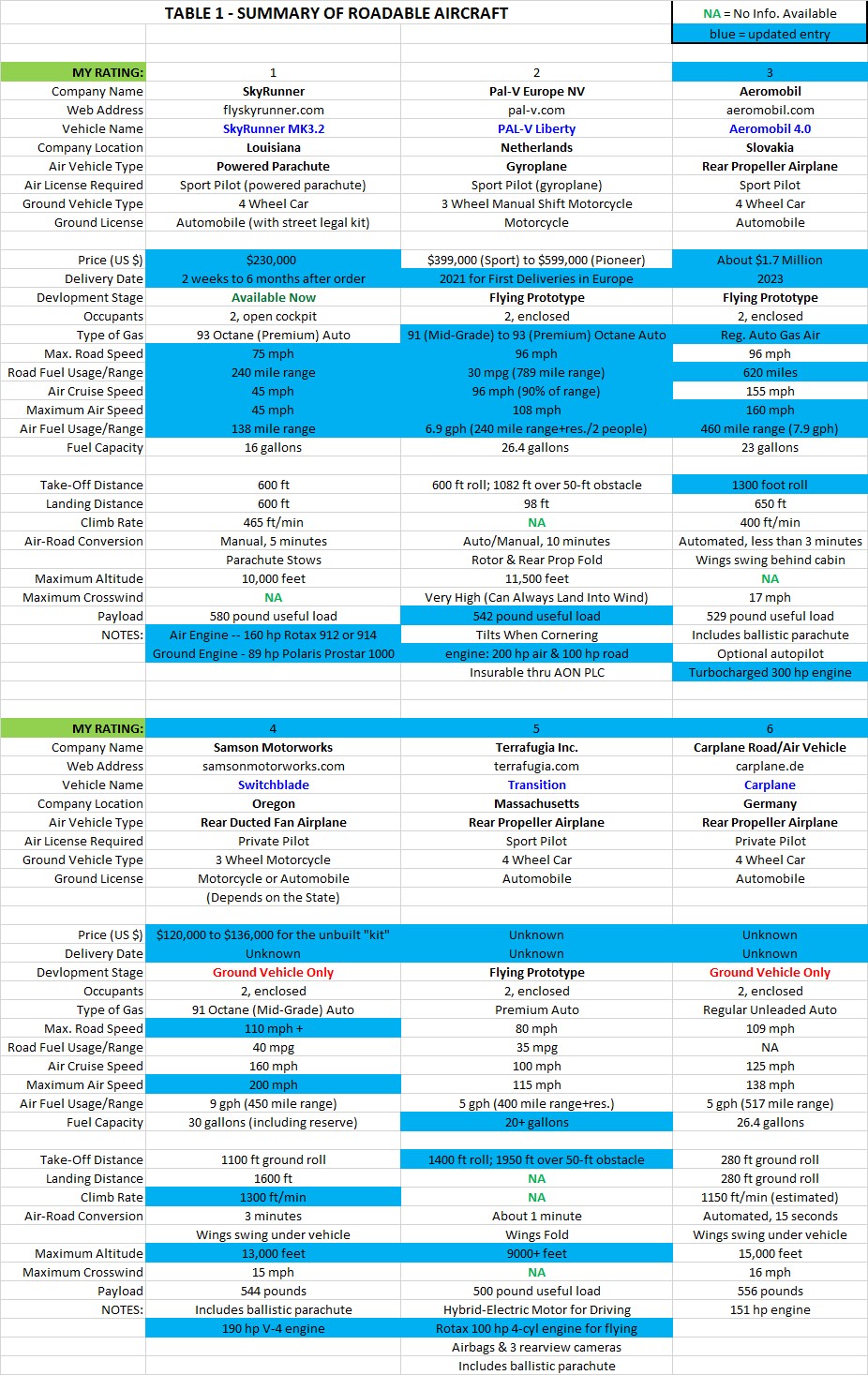

A number of "carplanes" have recently appeared on the market or will be appearing soon. The purpose of this site is to contrast and compare these vehicles and to provide the latest information on each. It is an unbiased site that is not funded by any of the manufacturers.
Edited by Jeffrey W. Buckholz, PhD, P.E., PTOE
The first carplane to have these key characteristics should dominate the market for awhile. As I see it, the major problem in bringing a carplane to market is the genral lack of capital funding. It takes a lot of money to finance such an endeavor and most of the organizations struggling with carplane design and production just don't have deep pockets. When Boeing, GM, Apple or some similar organization gets involved, things will change - and that may be starting to happen: Airbus Flying Car Ready by end of 2017? (nope, that didn't happen) There have also appeared articles that indicate Uber is looking at flying vehicles (Uber Elevate) as well as Google. Not sure if these are carplanes or just passenger-carrying drones but something is happening with the "big boys".

It is important to keep in mind the three basic problems that carplanes solve: the last mile problem, the weather problem, and the restricted airspace problem. Solving the last mile problem is accomplished through a carplane's ability to drive from the destination airport to your final desired location (and to the airport of origin from your point of beginning). Solving the weather problem is accomplished by the carplane's ability to land and drive through bad whether; and bad weather can be defined as anything from low cloud ceilings to high winds to thunderstorms ***. Solving the restricted airspace problem is accomplished by the carplane's ability to land and drive through areas that they might not be able to fly through due to airspace restrictions, such as occur near military installations and class bravo airports. Carplanes solve all of these problems without any backtracking. You can always land your general aviation aircraft and rent a car to drive to your final desired location, and this is doable even if the weather deteriorates. However, you're plane will be back at the airport and, at some point, you will have to backtrack to get it. This is not a big deal if you're going back to where you came from but it is a big deal if you're headed in a different direction. There is considerable travel freedom associated with a carplane that other modes of travel do not provide.
If a carplane does not solve all of these problems, then its really not a carplane. For example, passenger carrying drones are being developed that will be able to transport people directly from their point of beginning to their ultimate destination (in many cases, not all). This solves the last mile problem (in many cases, not all) but does not solve the weather or restricted airspace problems. You can solve these two problems without a carplane by simply waiting, or by risking either your life or your pilots license by flying, but neither of these options is very attractive.
If you want to see how people misunderstand the above discussion, read this article on the VOLOCOPTER. The volocopter is not a flying car because, although it may solve the last mile problem, it does not solve the weather problem or the restricted airspace problem. Here's another article where the term flying car (a variant of "carplane") is used to refer to what are really air taxi drone's. Misuse of the proper term is widespread; undoubtedly because there is no professional organization currently in place that could formally define the terms. It's time for such an organization and the Transportation Research Board would probably be the perfect professional organization to take this on. However, my emails to them encouraging this have been pretty much rejected without discussion. Too bad, because what is developing now will revolutionize transportation in the 21st century and they could get ahead of the game instead of having to react to it later on. Oh well.
*** The importance of being able to drive (without having to backtrack) when such driving is needed cannot be underestimated. Unflyable weather is relatively common and is not limited to thunderstorms. Many weather-related items can cause your trip to be delayed or canceled or, worse yet, can get you and your airplane stuck at some distant airport. Fog, high winds, high density altitude and even simple cloud cover (if you are not instrument rated - and most general aviation pilots are not) can ground you. Medical conditions, prescription drug use, emotional trauma, or even simple fatigue can also ground you whereas one can drive under most of these conditions. Also, many private pilots don't like flying at night even if the weather is good - with a carplane a pilot could switch to driving instead of flying at night. A carplane provides maximum transportation flexibility while avoiding the need to cancel a trip or spend a few days stuck in nowheresville. Drones, at least the current ones, cannot blast there way through bad weather, and they can't be driven so they do not provide the same level of transportation flexibility that carplanes do. This distinction needs to be understood.









